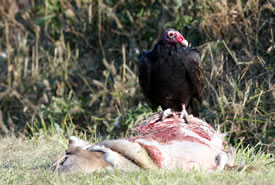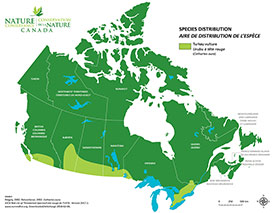
Turkey vulture (Photo by Bill Hubick)
Turkey vulture
Turkey vultures are a common sight along roads and highways, where they soar high on thermal currents and use their excellent sense of smell to find dead animals to scavenge.
What does the turkey vulture look like?
Adult turkey vultures are very large birds with long, broad wings, mostly dark brown feathers and sharply hooked white bills. They are named for their distinct red, bald heads, which look similar to that of a North American wild turkey.
Their bare head lets the birds stay germ-free when they are eating a carcass; otherwise their feathers would get dirty.
While they often feed near humans, turkey vultures prefer to roost and nest far from people in high secluded spots. If a turkey vulture is threatened, it will regurgitate semi-digested meat to lighten its body for a quick takeoff and escape.
What does the turkey vulture eat?
The species' diet consists primarily of mammals, although it will eat almost any dead animal they find, preferring a fresher kill to a badly decomposed carcass.
What does the turkey vulture sound like?
Turkey vultures communicate using low, guttural hissing sounds or nasal whining.
What is the turkey vulture's conservation status?
Although they are a common species, turkey vultures play an important role in our habitats. They are nature's "clean-up crew," and help to reduce the spread of disease by feeding on animal carcasses.






